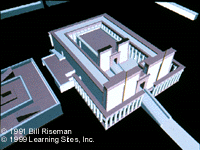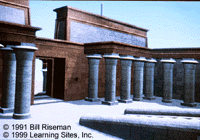Bill
Riseman constructed an experimental computer model using archaeological
evidence from the Sun Temple (ca. 250 BCE) at Meroe from material supplied to him in 1991 by Dr. Friedrich W. Hinkel, retired, East German Academy of Sciences, Berlin. With this model, Riseman studied the advantages and disadvantages of using different rendering engines to reproduce more complex shapes and scenes and to produce finished effects. Meroe is located after the fifth cataract of the Nile River, southeast of Gebel Barkal (click
here for map).
 |
The
computer model of the Sun Temple included all information about the building's
foundation walls, entrance ramp, hypostyle halls, and internal sequence
of temple spaces. The model also included other interior rooms and
exterior accessory structures. |
 |
The
basic vector data used to construct the models can be easily imported into
any rendering engine in general use. For example, when Riseman worked
on these data, there were simple shading programs, such as Velocity
by
CadKey, and more complex procedural shaders, such as Renderman
by
Pixar (similar then to the programs used by George Lucas of Industrial
Light and Magic), which use complex mathematical algorithms to calculate,
store, and display subtle variations in form, texture, and shading.
Riseman also experimented with 3D Studio by Autodesk and Crystal
3D by Time Arts, Inc. |
The
major disadvantage of simple shading or texture-mapping programs is the
repetitive nature of the applied textures, although they can be modified.
The programs tend to be quick, easy to apply, and flexible. Procedural
shaders, on the other hand, can generate more sophisticated textures all
produced from a few lines of programming code; therefore, they can reproduce
nearly infinite gradations and subtleties in textures that can be applied
to any type of surface. Their major disadvantage is their slow speed
to render out. |